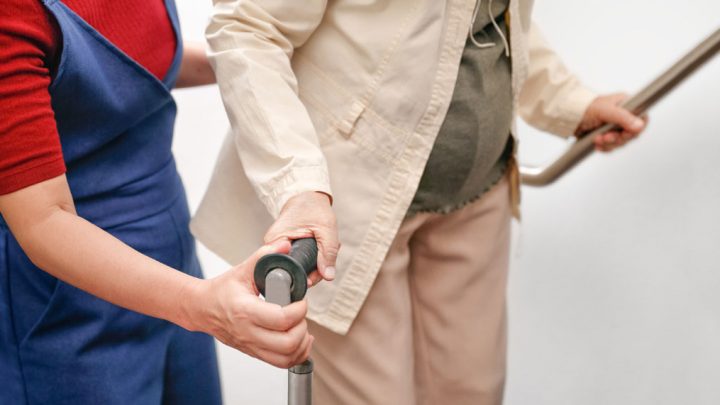The world is a difficult place to navigate right now and many are struggling to care for a loved one. It can be extremely challenging, even when circumstances allow one to do so in person, to provide care and concern for those located close by. When it comes to long-distance caregiving, there are many other obstacles that must be thought about and overcome when trying to give care and support one from far away.
According to AARP, eleven percent of families today give care to another family member that is located more than one hour away. The National Institute on Aging qualifies “care” as anything that involves helping with money management, arranging for in-person home care, planning for emergencies, lending emotional support, making medical appointments, researching community services, and other tasks like making decisions, investigating conditions and so on.
Whether the care receiver lives home alone, with a different family member, in an assisted living center or an actual residential facility, it is important to not underestimate how meaningful long-distance caregiving can be. Taking an active role, even while geographically spread apart, can help alleviate and augment responsibilities for those onsite and ensure that complete care is being received.
Financially, psychologically, and even physically draining, taking care of those outside of your geographical reach can be exceptionally hard. That’s why being prepared and organized can go a long way in making the challenges less demanding, particularly when it comes to care coordination at a distance.
For New Long-Distance Caregivers
Most people don’t automatically have caregiving skills. For those newly tasked with the matter, there are several steps to take when getting started that can ease the transition.
First off, if a primary caregiver exists, ask specifically how you can provide the most help possible. If you have friends that are in a similar position, use the community to source suggestions for how to be useful.
Then, it’s important to develop a good understanding of any health conditions that are present and what to expect in the future as it progresses. If and when possible, seek training to shore up caregiving skills and find a local community for those in similar situations. If you don’t know much about your family member’s health, talk to your own doctor to point you to knowledgeable resources.
Tips to Sustain Good Care
To bridge a distance gap, giving independence when desired and assistance when required, the following tips may prove helpful most effectively for those negotiating the logistical and emotional lifting in a situation of long-distance care.:
- Clear Path to Access
Access to clear, concise, and accurate information is an absolute must for primary caregivers. Figuring out early on any legal hurdles that need to be cleared for healthcare and financial decision-makers offers more than peace of mind, it solidifies a plan which forces answers to some of life’s most difficult questions. As a caregiver, this is an essential step in giving you power to provide the right type of care. - Tackling Tasks from a Distance
Understanding the tasks that can be well-executed from a distance is a great way to sustain support. Samples of care that fit into this category include educational resources to better enable you to understand a disease, care, and any treatment options available. Managing paperwork including insurance claims and medical billing are other tasks that aren’t geo-specific. - Delegate Responsibilities
Forming a network of caregiving helpers that includes medical professionals, friends and family can help alleviate the burden of care. It’s okay to task other willing individuals to participate in pitching in. Whether it’s walking a dog, mowing a yard, driving the care receiver to the doctor’s or pharmacy, creating a contact list with duties can go a long way in managing the many items involved. - Go Local
In many instances, hiring a local care manager may be a possibility to aid in aging life care or as a valuable mediator when making healthcare decisions. These types of parties often have years of experience managing a loved one’s care and can act as a point person on the ground. - Maximize Visits, When Possible
Whenever an in-person visit is possible, beyond spending time and being present with your loved one, be sure to schedule time conducting any necessary face-to-face appointments that include meeting with current or future service providers to discuss treatments and concerns.
Stages of Care
When assessing care needs for those with illnesses like Alzheimer, Parkinson, and other chronic health conditions, creating a helpful check-in list of questions is a great way to create a baseline for understanding independence. Conversely, it may help identify scenarios in which more hands-on care is required.
Early Stage
In early stages, asking a care receiver the following can illuminate current environmental circumstances:
- Is there food in your refrigerator?
- Are you eating regular meals?
- Are your bills paid?
- Do you have any unopened mail?
- Are you driving? Is it safe?
- Do you have regular visits from friends?
- How is your house?
- Do you need anything?
Middle and Late-Stage
As conditions devolve, and it is no longer safe to allow an individual to be left alone, there are several potential options to explore. The first is having an in-home caregiver provide a bulk of services. The next is moving the individual into a family home, and lastly is moving the individual to a residential care facility.
By consistently assessing the situation at hand, it’s easier to meet changing needs. In middle to later-stages of care, asking these questions can be helpful:
- Can you dress, bath and groom yourself?
- Do precautions need to be taken in a living environment?
- Is safe transportation available to go to a doctor’s office or a social engagement?
- What meaningful activities are you doing during the day?
- Is other care beyond family caregivers needed at this time?
With increasing limitations due to health and aging, loved ones may not be able to express their real needs from a distance. Others may withhold information about what they are experiencing or truly feeling to try and protect the individuals responsible for their care in an attempt to lighten the burden. If at all possible, making regular in-person time is invaluable in understanding exactly what the situation is.
Navigating Guilt
Most long-distance caregivers struggle with the guilt of not being present. At Senior Support Solutions, we just want to take a moment to acknowledge that it can be a hard thing to juggle with your own life and its pressing demands. Finding a community to share these feelings with is one way to find relief. Another is to learn how to give yourself permission to feel guilty but know that you are doing the best you can.
Taking Care of Yourself Too
When giving care to another, it’s critical that you not neglect self-care. In fact, caring for yourself is one of the most important things you can do as a caregiver. The effects can be disastrous on your health and wellbeing otherwise. The combination of stress, demands, and vulnerabilities can really take a toll. If you experience any of the following, it is imperative to get help:
- Insomnia or sleep deprivation
- Loss of weight or significant weight gain
- Inability to motivate
- Failure to exercise
- Not able to make self-medical appointments when needed
- Depression
- Substance abuse
- High blood pressure
- Exhaustion
With 46 percent of caregivers diagnosed as clinically depressed, don’t let your own health get away from you. While you can’t stop a progressive illness or aging from happening, you can ensure that your own needs are met that can enable you to be a better caregiver.
If at any point in time, you can no longer handle the situation, there are resources available. Depending on the illness or scenario, strategies exist to help you navigate. Whether you are struggling talking with doctors, working with siblings, relocating your parents, dealing with legal issues or otherwise, the chances are that you aren’t the first. Lean on existing knowledge!
Taking on a New Role
Regardless of your age or your own health status, taking on the care of another is never simple. It is common to feel stressed or overwhelmed. Experiencing a range of feelings from sadness to grief, anger to guilt, is completely normal, and honestly, to be expected. It’s okay to know that you’ll make mistakes in taking on this new role. You don’t have to pretend to be cheerful all of the time and we encourage you to express your feelings.
Last but not least, be hopeful. While change is a part of life, so is love, joy and peace. You are taking steps to help your family and a loved one and it’s a noble cause.
Get Help
It’s not easy but you don’t have to take on everything alone. For further guidance on tackling long distance caregiving, our team at Senior Support Solutions can help. Remember, you don’t have to ever be afraid to ask for questions or to ask for help.




